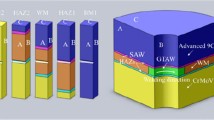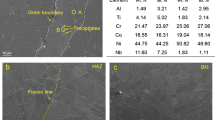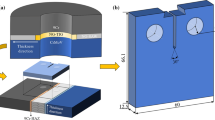Abstract
The relationship between the microstructure and impact toughness, especially the formation of the lamellar carbides and its effect on the impact toughness of the heat-affected zone of Alloy 617 (Alloy 617-HAZ), was systematically investigated. Impact test was performed on Alloy 617/9%Cr dissimilar welded joints aged for different time at 620 °C. The results showed that the characteristic zones of the whole welded joint revealed decreased impact toughness with increasing the aging time. The impact energies in weld metal showed high stability despite the aging process, while the Alloy 617-HAZ for all testing specimens presented the lowest impact toughness with various aging time. Meanwhile, the mixed grains were found in the base metal (BM) and heat-affected zone of Alloy 617, together with the twins with different widths located in the interior of the large grains. The columnar and equiaxed grain zones appear alternately due to the multilayer and multi-pass welding technique. In particular, compared with Alloy 617-BM, coarsened and even lamellar carbides were observed in Alloy 617-HAZ. These special carbides can separate the grains and therefore result in the formation of intergranular fracture morphology in Alloy 617-HAZ. Besides, the microhardness distribution was tested with a proper load, and the results exhibited that the weld possessed the highest hardness for all specimens with various aging time. The higher microhardness in Alloy 617-HAZ compared with that in Alloy 617-BM was attributed to the high density of the dislocations, which could be detected by transmission electron microscope. As a result, the coarsened carbides aggregated in the grain boundaries to form the lamellar layer are deemed as the main factor to reduce the impact toughness in Alloy 617-HAZ.















Similar content being viewed by others
References
K. Mo, G. Lovicu, X. Chen, H.M. Tung, J.B. Hansen, and J.F. Stubbins, Mechanism of Plastic Deformation of a Ni-Based Superalloy for VHTR Applications, J. Nucl. Mater., 2013, 441, p 695–703
V. Knežević, J. Balun, G. Sauthoff, G. Inden, and A. Schneider, Design of Martensitic/Ferritic Heat-Resistant Steels for Application at 650 °C with Supporting Thermodynamic Modelling, Mater. Sci. Eng. A, 2008, 477, p 334–343
K. Yamamoto, Y. Kimura, and Y. Mishima, Effect of Matrix Microstructure on Precipitation of Laves Phase in Fe-10Cr-1.4W (-Co) Alloys, Intermetallics, 2006, 14, p 515–520
J. Hald, Microstructure and Long-Term Creep Properties of 9-12% Cr Steels, Int. J. Press. Vessels Pip., 2008, 85, p 30–37
H. Yin, Y. Gao, and Y. Gu, Evolution of the Microstructure and Microhardness of the Welding Joint of IN 740H Alloy with IN 617 as Filler Metal, Mater. Charact., 2017, 127, p 288–295
Y. Guo, B. Wang, and S. Hou, Aging Precipitation Behavior and Mechanical Properties of Inconel 617 Superalloy, Acta Metall. Sin., 2013, 26(3), p 307–312
A.K. Roy, M.H. Hasan, and J. Pal, Creep Deformation of Alloys 617 and 276 at 750–950 °C, Mater. Sci. Eng. A, 2009, 520(1), p 184–188
Q. Wu, H. Song, R.W. Swindeman, J.P. Shingledecker, and V.K. Vasudevan, Microstructure of Long-Term Aged In617 Ni-Base Superalloy, Metall. Mater. Trans. A, 2008, 39(11), p 2569–2585
H. Jiang, J.X. Dong, M.C. Zhang, and Z.H. Yao, Phenomenological Model for the Effect of Strain Rate on Recrystallization and Grain Growth Kinetics in the 617B Alloy, J. Alloy. Compd., 2018, 735, p 1520–1535
J. Haan, A. Bezold, and C. Broeckmann, Interaction Between Particle Precipitation and Creep Behavior in the Ni-Base Alloy 617B: Microstructural Observations and Constitutive Material Model, Mater. Sci. Eng. A, 2015, 640(5), p 305–313
H. Jiang, J.X. Dong, M.C. Zhang, L. Zheng, and Z.H. Yao, Hot Deformation Characteristics of Alloy 617B Nickel-Based Superalloy: A Study Using Processing Map, J. Alloy. Compd., 2015, 647, p 338–350
D. Tytko, P.P. Choi, J. Klöwer, A. Kostka, and G. Inden, Microstructural Evolution of a Ni-Based Superalloy (617B) at 700 °C Studied by Electron Microscopy and Atom Probe Tomography, Acta Mater., 2012, 60(4), p 1731–1740
H. Shah Hosseini, M. Shamanian, and A. Kermanpur, Characterization of Microstructures and Mechanical Properties of Inconel 617/310 Stainless Steel Dissimilar Welds, Mater. Charact., 2011, 62(4), p 425–431
J. Kim, S.H. Kim, K.J. Choi, C.B. Bahn, I.S. Hwang, and J.H. Kim, In-situ Investigation of Thermal Aging Effect on Oxide Formation in Ni-Base Alloy/Low Alloy Steel Dissimilar Metal Weld Interfaces, Corros. Sci., 2014, 86, p 295–303
H. Naffakh, M. Shamanian, and F. Ashrafizadeh, Dissimilar Welding of AISI, 310 Austenitic Stainless Steel to Nickel-Based Alloy Inconel 657, J. Mater. Process. Technol., 2009, 209(7), p 3628–3639
H. Cerjak, P. Hofer, and B. Schaffernak, The Influence of Microstructural Aspects on the Service Behaviour of Advanced Power Plant Steels, Trans. Iron Steel Inst. Jpn., 2007, 39(9), p 874–888
F. Abe, H. Araki, and T. Noda, The Effect of Tungsten on Dislocation Recovery and Precipitation Behavior of Low-Activation Martensitic 9Cr Steels, Metall. Trans. A, 1991, 22(10), p 2225–2235
H. Gao, Y. Zhang, H. Zhang, H.J. Li, and F. Qu, Precipitates and Particles Coarsening of 9Cr-1.7W-0.4Mo-Co Ferritic Heat-Resistant Steel After Isothermal Aging, Sci. Rep., 2017, 7(1), p 58–59
H.G. Armaki, R. Chen, K. Maruyama, and M. Igarashi, Creep Behavior and Degradation of Subgrain Structures Pinned by Nanoscale Precipitates in Strength-Enhanced 5 to 12 pct Cr Ferritic Steels, Metall. Mater. Trans. A, 2011, 42(10), p 3084–3094
K. Sawada, K. Kubo, and F. Abe, Creep Behavior and Stability of MX Precipitates at High Temperature in 9Cr-0.5Mo-1.8W-VNb Steel, Mater. Sci. Eng. A, 2001, s319–s321(15), p 784–787
M.G. Park, C.H. Lee, J. Moon, J.Y. Park, and T.H. Lee, Effect of Microstructural Evolution by Isothermal Aging on the Mechanical Properties of 9Cr-1WVTa Reduced Activation Ferritic/Martensitic Steels, J. Nucl. Mater., 2017, 485, p 15–22
K. Miyahara, J.H. Hwang, and Y. Shimoide, Aging Phenomena Before the Precipitation of the Bulky Laves Phase in Fe-10%Cr Ferritic Alloys, Scr. Metall. Mater., 1995, 32(12), p 1917–1921
P. Yan and Z.D. Liu, Toughness Evolution of 9Cr-3W-3Co Martensitic Heat Resistant Steel During Long Time Aging, Mater. Sci. Eng. A, 2016, 650, p 290–294
Y.H. Wei, S.F. Qiao, F.G. Lu, and W. Liu, Failure Transition Mechanism in Creep Rupture of Modified Casting 9Cr-1.5Mo-1Co Welded Joint, Mater. Des., 2016, 97, p 268–278
M. Speicher, F. Kauffmann, J.H. Shim, and M. Chandran, Microstructure Evolution in Alloy 617 B After a Long-Term Creep and Thermal Aging at 700 °C, Mater. Sci. Eng. A, 2018, 711, p 165–174
H. Ahmad, J.H. Hwang, L. Ju, and B. Dong, An Assessment of the Mechanical Properties and Microstructural Analysis of Dissimilar Material Welded Joint Between Alloy 617 and 12Cr Steel, Metals, 2016, 6(10), p 1–11
Y. Zhang, H. Jing, L. Xu, Y. Han, L. Zhao, and B. Xiao, Microstructure and Mechanical Performance of Welded Joint Between a Novel Heat-Resistant Steel and Inconel 617 Weld Metal, Mater. Charact., 2018, 139, p 279–292
X. Liu, Z.P. Cai, X.L. Deng, and F.G. Lu, Investigation on the Weakest Zone in Toughness of 9Cr/NiCrMoV Dissimilar Welded Joint and its Enhancement, J. Mater. Res., 2017, 32(16), p 3117–3127
L. Ceschini, A. Maeconi, C. Martini, and A.D. Schino, Tensile and Impact Behaviour of a Microalloyed Medium Carbon Steel: Effect of the Cooling Condition and Corresponding Microstructure, Mater. Des., 2013, 45(6), p 171–178
Y.R. Im, J.O. Yong, B.J. Lee, J.H. Hong, and H.C. Lee, Effects of Carbide Precipitation on the Strength and Charpy Impact Properties of Low Carbon Mn-Ni-Mo Bainitic Steels, J. Nucl. Mater., 2001, 297(2), p 138–148
W. Liu, X. Liu, F.G. Lu, X.H. Tang, H.C. Cui, and Y.L. Gao, Creep Behavior and Microstructure Evaluation of Welded Joint in Dissimilar Modified 9Cr-1Mo Steels, Mater. Sci. Eng. A, 2015, 644, p 337–346
C.D. Shao, F.G. Lu, Z.G. Li, Y. Cai, and P. Wang, Role of Stress in the High Cycle Fatigue Behavior of Advanced 9Cr/CrMoV Dissimilarly Welded Joint, J. Mater. Res., 2016, 31(2), p 292–301
H.L. Xu, W. Liu, F.G. Lu, P. Wang, and Y.M. Ding, Evolution of Carbides and its Characterization in HAZ During NG-TIG Welding of Alloy 617B, Mater. Charact., 2017, 130, p 270–277
C.K. Sudbrack, K.E. Yoon, R.D. Noebe, and D.N. Seidman, Temporal Evolution of the Nanostructure and Phase Compositions in a Model Ni-Al-Cr Alloy, Acta Mater., 2006, 54(12), p 3199–3210
W. Liu, F. Lu, X. Tang, R. Yang, and H. Cui, The Microstructure Evolution and Element Segregation of Inconel 617 Alloy Tungsten Inert Gas Welded Joint, J. Mater. Res., 2016, 31(4), p 435–442
Q.B. Zhang and J.X. Zhang, Fatigue Crack Growth Behavior of a New Type of 10% Cr Martensitic Steel Welded Joints with Ni-Based Weld Metal, J. Mater. Eng. Perform., 2017, 26(8), p 3921–3928
Q.J. Wu, F.G. Lu, H.C. Cui, X. Liu, P. Wang, and X.H. Tang, Role of Butter Layer in Low-cycle Fatigue Behavior of Modified 9Cr and CrMoV Dissimilar Rotor Welded Joint, Mater. Des., 2014, 59, p 165–175
O.M. Barabash, J.A. Horton, S.S. Babu, J.M. Vitek, and S.A. David, Evolution of Dislocation Structure in the Heat Affected Zone of a Nickel-Based Single Crystal, J. Appl. Phys., 2004, 96(7), p 3673–3679
M. Koyama, Y. Yamamura, T. Sawaguchi, K. Tsuzaki, and H. Noguchi, Microstructural Hardness Heterogeneity Triggers Fatigue Crack Non-propagation in as-Hot-Rolled Fe-30Mn-3Si-3Al Twinning-Induced Plasticity Steel, Int. J. Fatigue, 2018, 108, p 18–24
Acknowledgments
The authors gratefully acknowledge the financial support by the Program for Professor of Special Appointment (Eastern Scholar) at Shanghai Institutions of Higher Learning (No. TP2014042) and People’s Republic of China and Shanghai Science and Technology Committee (No. 13DZ1101502).
Author information
Authors and Affiliations
Corresponding author
Rights and permissions
About this article
Cite this article
Ding, K., Wang, P., Liu, X. et al. Formation of Lamellar Carbides in Alloy 617-HAZ and Their Role in the Impact Toughness of Alloy 617/9%Cr Dissimilar Welded Joint. J. of Materi Eng and Perform 27, 6027–6039 (2018). https://doi.org/10.1007/s11665-018-3668-0
Received:
Revised:
Published:
Issue Date:
DOI: https://doi.org/10.1007/s11665-018-3668-0




